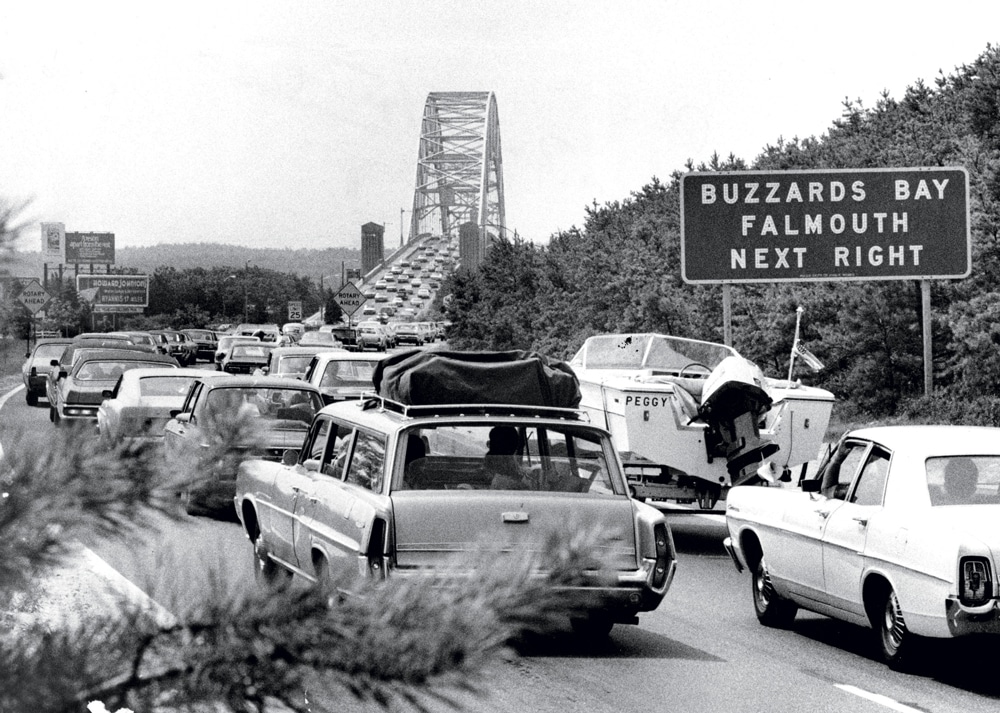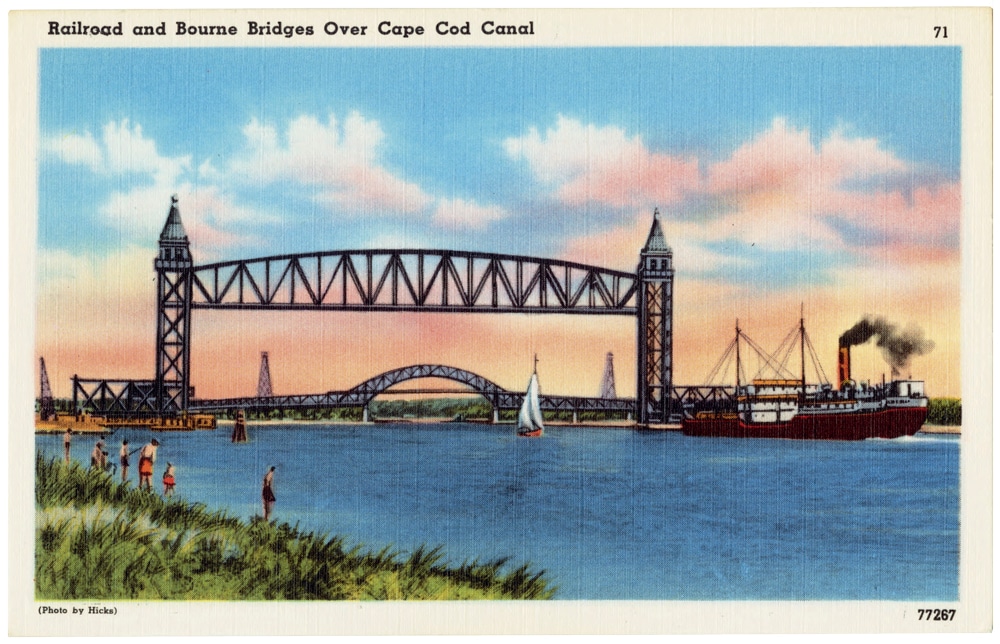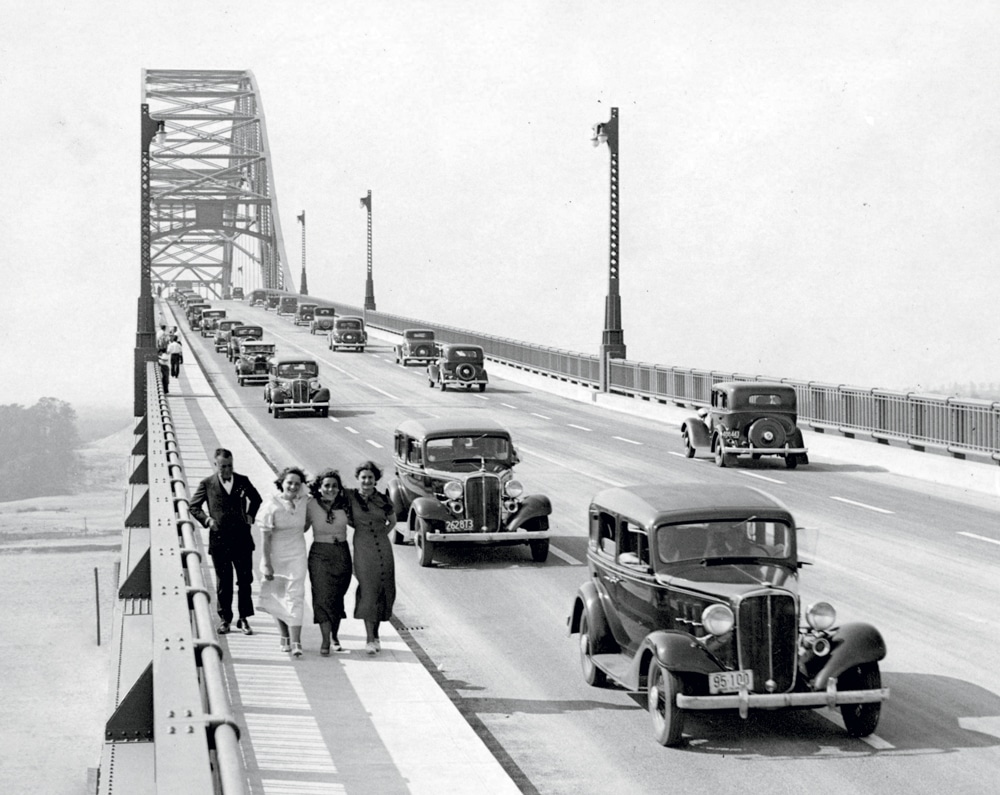The Bridges of Barnstable County | An Ode to the Cape Cod Bridges
Three bridges not only connect Cape Cod to the mainland, but also link visitors and residents with treasured summer memories. Here’s why we love the Bourne, Sagamore, and Railroad Bridges.

Coffee By Design | Portland, Maine
Photo Credit : Katherine Keenan
Photo Credit : William Ryerson/The Boston Globe via Getty Images
I see the bridge!”
The car is jam-packed with suitcases and coolers, deflated floats, and five pairs of flip-flops still dusted with last summer’s sand. The bicycle wheels are spinning on the rack behind you, but you’re facing forward now, eyes on the horizon. Because the first kid who spots the bridge gets the satisfaction of being the first kid who spots the bridge.
You remember.
“I see the bridge!” With those words, your Cape Cod vacation begins. Crossing the water, you are squirming in the back seat, trying to get a look at the marine traffic below. Around 14,000 vessels move through the Cape Cod Canal every year. You’re hoping for a tugboat—and wouldn’t it be cool to see a barge? Or maybe the Railroad Bridge is in motion, lowering its center span to welcome a train. When you were younger, you pictured an enchanted locomotive steaming straight up one tower, making a right-angle turn to cross the span, then right-angling again to go straight down on the other side.
You know better now. Or do you?

Photo Credit : Boston Public Library
It’s true that the bridge comes down to meet the train, but it’s also true that the bridges of Barnstable County are magic. The understated elegance of the twinned Bourne and Sagamore, the arresting riveted spires of the Railroad Bridge, the working scenic waterway below. For residents and visitors alike, traversing the canal at any age marks a passage to another place. Those of us who live on Cape Cod (215,000 at last count) feel our shoulders drop, our breath deepening, a sense of rightness to the world as we head toward home. For visitors, there is the tingle of anticipation mid-span, a movement from work to play, busyness to calm. (Or as calm as it gets with those kids in tow.) Some local bridge lovers never even cross; they live canal-side on the mainland, spellbound, and reveling in views.
The Graceful Sisters
Wait—what about the traffic? During peak travel times, backups are notorious, particularly on the Sagamore, which carries the bulk of the traffic to and from Boston. (Travelers from the west or south tend to favor the Bourne, the longer of the two bridges, 2,384 feet to the Sagamore’s 1,408.) Delays can diminish the allure of arrival, though not so much for residents, as we follow strict rules around coming and going to avoid getting stuck. But on the flip side, we endure the repairs and maintenance that are routine in the off-season. (For painting, the bridges are wrapped, Christo-like, in billowing cloth, lest you recognize year-rounders by their gunmetal-dotted vehicles.)
Built in the 1930s and designed by esteemed Boston architect Ralph Adams Cram, both the Bourne and Sagamore accommodate two tight lanes each way. They replaced an older set of bridges installed before the 1914 opening of the Cape Cod Canal, the brainchild of entrepreneur August Belmont Jr., who also financed and constructed the original New York City subway. And in case you’re wondering why someone would stake his fortune on a remote canal, it was all about commerce—saving time—and also keeping sailors alive. Traders and merchants had wanted to merge two tidal rivers since the 1600s. On the route around the Cape, shipwrecks were routine (between 20 and 30 annually in the late 1800s). But things didn’t work out exactly as planned on that first attempt. At 25 feet deep and just 100 feet wide, the original canal shaved 62 dangerous miles off the trip. But the high tolls, sharp turns, and tight navigation put off mariners, and the private project was a commercial failure. In 1928, the federal government purchased the canal and the Army Corps of Engineers took over, dredging and reconfiguring, straightening its course, making it deeper (32 feet) and wider (480 feet) and installing giant rocks as riprap along the banks to minimize erosion.

Photo Credit : The Boston Globe via Getty Images
Someday, the Bourne and Sagamore bridges will be retired. Last year the federal government allocated funding and an agreement was forged that will enable the state to take over two new bridges once they are built. The design process will take a while, and there’s engineering, highway planning, and all the figuring out that will be required to build modern six-lane spans with bike paths and sidewalks that connect the Cape and the mainland. For the next decade or so? Let’s cherish the sisters’ sunset silhouettes.
The Stately Sentinel
Presiding over the western end of the canal, the Cape Cod Canal Railroad Bridge is a world wonder of ironwork, design, and engineering. Most often seen in its raised position, the center span is 135 feet above the high-water level and punctuated by two trussed towers capped with ironwork cones and spheric finials. If you could climb to the very top and hang on to one of those giant balls, you’d be 271 feet from the water below.
The Art Deco style of the c. 1935 bridge can be credited to McKim, Mead & White, architectural superstars of their day, whose New England projects include the Boston Public Library and the Rhode Island state capitol. Visible from the Bourne Bridge and the canal-side trails, the Railroad Bridge can be seen up close from Buzzards Bay Park. You can also cross it yourself on a scenic excursion with the Cape Cod Central Railroad or on the MBTA’s Cape Flyer service from Boston. And here’s a secret: The Railroad Bridge whistles. When canal-side residents hear that distinctive sound, they know the 544-foot center span will soon be lowered. That span weighs 2,200 tons; two 1,100-ton counterweights (one in each tower) facilitate its movement, using minimal electricity. In just two and a half minutes, the bridge is down, rails ready for the oncoming train.
Function—yes, for sure—but form. Oh, form. The bridges of Barnstable County. Three love stories spanning a single canal, a romance that never ends.
I see the bridge.








Wonderful comments
Love the bridged
I loved, loved. loved this issue! It brought back such precious and wonderful memories of my two decades of Yarmouth summers that I long for again!We were probably one of those cars in that photo of the Bridges of Batnstable County story. Leaving the Cape along Rte. 28 on Labor Day was always the longest and saddest ride because we never wanted to leave. Once over the Bourne bridge we would always stop at the Ocean Spray store to pick up Mom a dozen cranberry crumble bar desserts. Thankyou for bringing back the treasured family memories and Best Summers ever!
Thank you for this article about my three favorite bridges in the world! For much of my childhood I lived in the shadow of the railroad bridge. I rode the school bus across the Bourne Bridge for years, then for a few years, after my folks purchased and ran a motel in Bournedale, I rode over the beloved Cape Cod Canal on the Sagamore Bridge to Bourne High School. Everyday I waved to sailors going past my home, often as I sat on the rocks studying Latin. I know how blessed I was to grow up having these marvelous bridges in sight. I miss them and often dream of living on the canal once again. Your article and photos brought back many wonderful memories!
We used to commute from Stoughton ma to Scenic Park a combination picnic/camping ground, back in the early 60’s(before they paved it uggh!)It was at the foot of the north side of the Bourne bridge.. cookouts,all the sides,and a swing set area in the woods with an old fashioned well and pump..ship traffic on the canal was much heavier back then,and would sometimes blow a salute….”ah,time..like a gray shadow,pursuing us all…but even time can’t take those memories..they are forever” Jean Shepherd.
They are graceful.
Thank you for that bridge traffic photo and the memories. My family was stuck in that jam, two cars loaded with kids and groceries and a red canoe. We went onward to a shack in Brewster facing the bay. Sunburns and sandy sheets, the taste of steamer clams in butter, and the crisp smell of crushed bayberries. Going way out hunting for clams at low tide. Time stood still, for a while. Even now, fifty years later, living north of Seattle, these memories come on as strongly as yesterday’s activities. With love from Arlington, Washington.